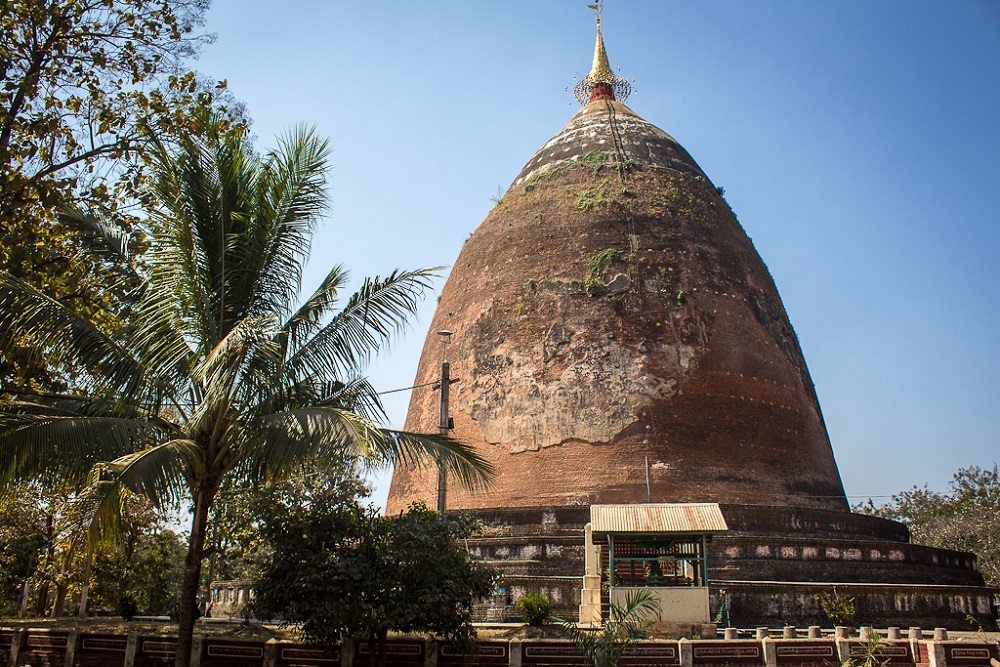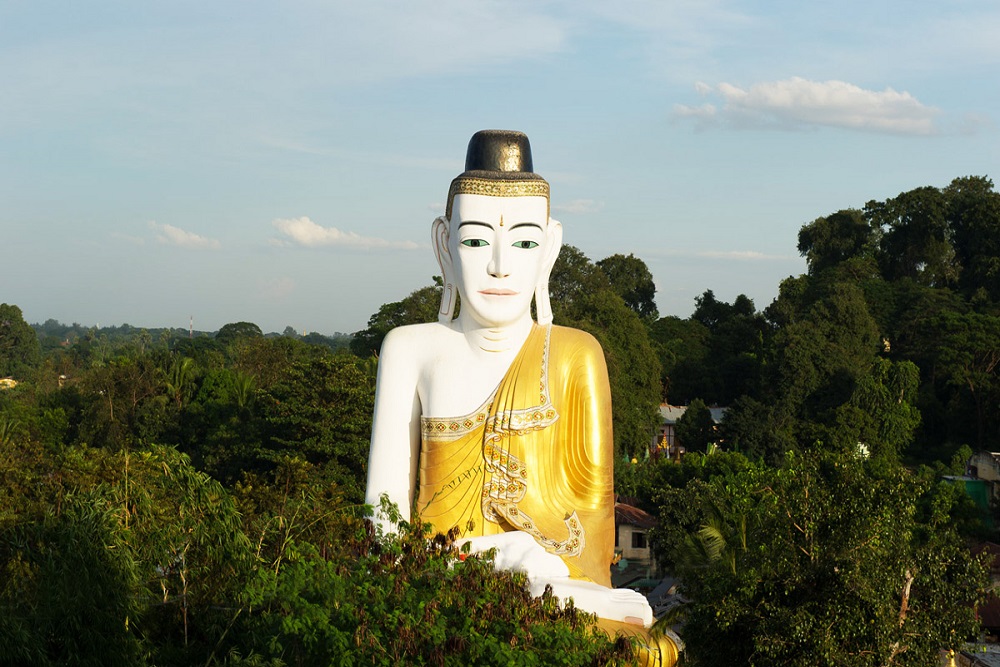About Pyay
Pyay, formally known as Prome, connects the Ayeyarwady Delta, Central and Upper Myanmar, and the Rakhine (Arakan) State as one of the important commercial centers for trade.
In ancient times, Pyay was known as Tha-ye-khit-taya, or Sri Kshetra, the capital of the Sri Ksetra Kingdom, until after the Second Anglo-Myanmar war when it was Anglicized to Prome. The ruins of Sri Kshetra are located about 5 miles (8 km) east of modern Pyay and are a point of interest because of the ancient city’s historical importance and enduring archaeological sites.
Such archaeological and religious sites have become main attractions in Pyay. These sites include the Shwesandaw Pagoda, Sehtetgyi Pagoda, which houses a gigantic sitting Buddha image, Baw Baw Gyi Pagoda, Be Be Gyi Pagoda, and Payama Pagoda. Other places include Ahkauktaung, Shwe Myatman Stupa, Shwe Nat Taung Pagoda, Shwe Bonthar Muni, and the Hmawza (Sri Kshetra) Museum.
Sri Kshetra: Where Pagodas Began
Sri Kshetra (or Tha-ye-khit-taya), the ancient Pyu capital, is about 5 miles southeast of Pyay and about 177 miles northwest of Yangon. Historical evidence indicates that the city reached the heights of prosperity between the 5th and 9th centuries.
This ancient city contains some of the oldest pagodas in Myanmar, the Baw Baw Gyi Pagoda, the Payagyi, and Payama (sometimes spelled Phaya Mar) Stupas. It also has palace sites that were the prototypes for Bagan’s vaulted temples, such as the Lemyethna Temple. Visitors are encouraged to learn more about the history of the area at the Sri Ksetra Museum.
Attractions in Pyay
Shwesandaw Pagoda
Well-known in Pyay and known as one of Myanmar’s most venerated structures, the Shwesandaw Pagoda is located on a small hill, on the eastern bank of the Ayeyarwady River.
The pagoda has five terraces with a cylindrical stupa on top, which then supports a bejeweled umbrella, also known as an hti. It is 127ft (39m) tall and when measured from the base of the plinth, comes to a total height of 290ft (88m). Also around the main pagoda are 64 smaller pagodas.
Shwesandaw means “Golden Hair Relic” and as such is said to house a few of the Buddha’s hairs.
The southern sector of the pagoda platform also contains a duplicate of the Buddha’s tooth relic of Kandy, Sri Lanka. Because the duplicate was placed next to the original, the duplicate is believed to have absorbed some of the energy of the original. It is now considered just as powerful as the original relic.
Every year during the month of Dazaungmone in the Myanmar calendar (November-December), the tooth relic is removed from its chamber in the pagoda. It is also taken on a ceremonial tour of the city every three years so worshippers are able to pay homage and see the relic personally.
Hse-htat-gyi Paya (The Gigantic Sitting Buddha Image)
To the east of the Shwesandaw pagoda is the Hse-htat-gyi (often spelled as Sehtatgyi) Paya, or Pagoda. Shetatgyi means “Big Ten Storey”, referring to the massive height of the seated Buddha figure.
Baw Baw Gyi Pagoda and Bebe Paya
Outside of the city wall, to the south of the musuem, is the Baw baw Gyi Paya and the Bebe Paya. The cylindrical Baw Baw Gyi Paya is a little over 45 meters high and made of brick and plaster. It is also the oldest stupa in the area. The Bebe Paya is one among the many cube-shaped pagodas in the area, including one that was thought to have been used by a hermit.
Payama Pagoda
Even though the Payama (Phayamar) Pagoda’s design is similar to another pagoda called the Payagyi Pagoda, it has the distinction of being one of the oldest stupas in all of Myanmar. This pagoda has a golden umbrella (hti) sitting on top of its high brick dome. The entire dome is raised from the ground by a series of small stepped platforms.
The Payama Pagoda can be found along the road heading to Paungtale, outside of old Therakhittra.
Akauk Taung Mountain
In the Bago Division, to the north of Pyay, is Akauk Taung Mountain, on the banks of the Ayeyarwady River. Even though the “mountain” is more like a hill, its face along the side of the river contains a large variety of different sizes and styles of Buddha images, 30-50 feet about sea level. There is a small path along the mountain that leads to the Akauk Taung Pagoda, which sits on top of the mountain.
From Pyay, it takes about 15 minutes by boat to reach Akauk Taung.
Shwe Myatman Stupa
About 14km south of Pyay in Shwe Daung is the Shwe Myatman Stupa. Shwe Myatman’s meaning is the “Stupa with the Golden Spectacles”. This name references the sitting Buddha image in the stupa that wears gold-rimmed spectacles. The spectacles were added to the image during the Konbaung era. It’s said that this particular image of the Buddha can cure eye-related illnesses.
Shwe Nat Taung Pagoda
Dating back to the Sri Ksetra era, the name Shwe Nat Taung means “Golden Spirit Mountain” which refers to an ancient legend from 283 BC. The legend tells the tale of the construction of the pagoda by a long reign of Myanmar kings with the help of the local nats (spirits).
There is a festival held at the pagoda every year on the full moon of Tabaung in the Myanmar calendar (February/March).
Shwe Bonthar Muni Pagoda
Also near Pyay, at Pan Daung, is the Shwe Bonthar Muni Pagoda. The legend surrounding this pagoda states that the Buddha image inside this pagoda is only one of three replicas of the Maha Myat Muni Buddha image, created around 554 BCE during the reign of King Sandar Thuriya. The Maha Myat Muni Buddha image is said to be one of the only five images of the Buddha that were made during his lifetime.
Hmawza (Sri Kshetra) Museum
At the Hmawza village in Pyay is the Sri Kshetra Museum. The museum is one story and has three halls arranged in the shape of the English letter “U”. The artifacts and objects within help narrate the story of Pyu’s impressive culture about 2000 years ago.
Pyay is located around 180 miles northwest of Yangon, on the eastern bank of the Ayeyarwady River, which you can get to on a well-maintained highway by car. Along your drive, about a 6-hour journey, you’ll see green paddy fields as part of the scenery.
You can also reach Pyay from Yangon along the first railway line built in the country in 1877. Since the city is halfway between Yangon and Bagan, Pyay is now a stop along the way to Bagan, or farther north to Mandalay, ever since the railway company extended their branch lines. There are also express buses that send curious travelers from Yangon to the city every day.
Interested in festivals? read more about festivals in Pyay and around Myanmar.
DESTINATIONS IN CENTRAL MYANMAR
Bagan
Mandalay
Shwebo
Mt Popa
Pyin Oo Lwin
Taungoo


